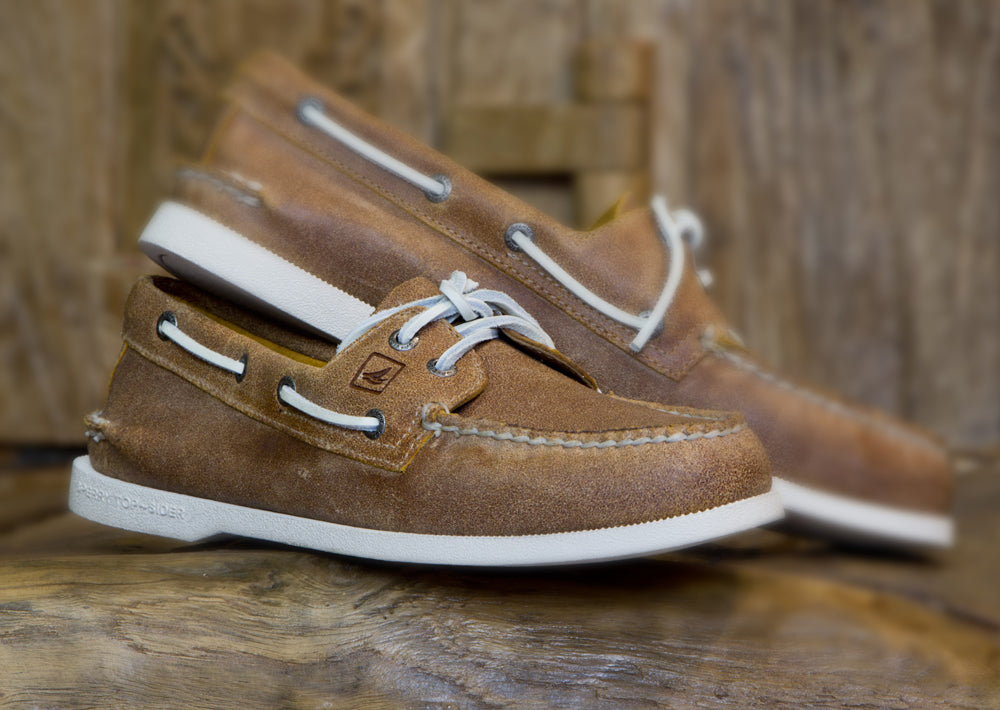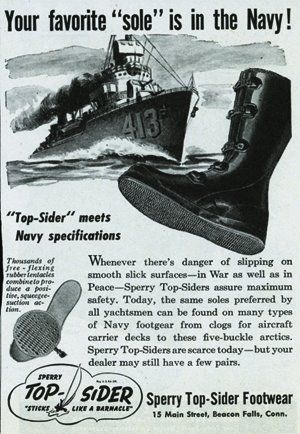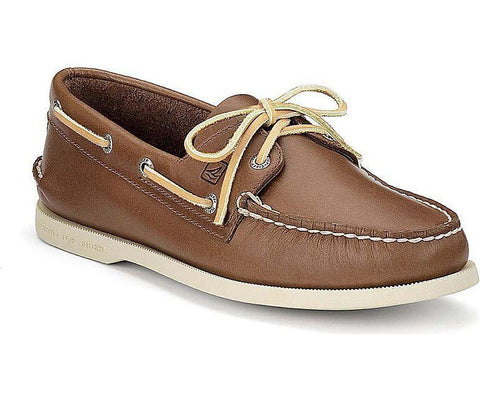The History of Sperry Boat Shoes: The Story of a Dog, A Guy, and a Vision

A lot of cool things in life begin with a great doggo story.
Personally, my favorite kind of pup story is the tale of a guy and his loyal dog doing something together and, in the end, the man learning a greater lesson from his friendly K9 companion about life (even if the dog dies tragically in the last five minutes of the story). Off the top of my head, I’m thinking of my favorite dog/man films: Isle of Dogs, My Dog Skip, Marley and Me, and the best of all time, Turner and Hooch. All of these movies have something very distinct in common — the dog allows the man to discover something they otherwise wouldn’t have discovered themselves.
And so, with that anecdotal intro out of the way, you can kind of predict that the story of boating shoes would be no different...
Dog vs. Ice: the story of the century

It all began on a snowy winter day in Connecticut back in 1935. A man by the name of Paul Sperry (yes, the same Sperry you’re thinking of) was playing with his Cocker Spaniel in the snow, and, according to Connecticut historians, became infatuated with his dog’s ability to run and play on ice without slipping.
Most people in the same situation would just think, "Oh wow, that's pretty cool. My dog has great balance" and continue living their normal lives... but not Mr. Paul Sperry. He immediately became curious as to how this was happening and, after observing his Cocker Spaniel’s paws and noticing parallel divets in the skin, hatched an idea that was likely influenced by a traumatic experience he had slipping off the deck of a boat as a 20-year-old sailor (an exciting survival story that we unfortunately don't have time to cover in this article).
Sperry wanted to translate his dog's biological non-slip paw design into boating shoes to prevent unnecessary slip-related boating accidents. So, over the course of a few wintery months, he experimentally applied the same design on the bottom of his dog's paws to pieces of quarter-inch thick rubber and tested them for traction on wet floors. At some point, he crafted a piece of rubber that increased traction exceptionally -- but only when force was applied forward and backwards. He then decided to apply the same concept, with zigzag parallel divets instead of straight lines, on another piece of rubber. This time something was clear to Paul Sperry: he was on to something nobody else had thought of.

Sperry must have also realized that the market for highly effective, technical non-slip boating shoes was in need of genuine innovation. At that moment in time, non-slip boating shoes were either of “canvas uppers with a slab of crepe rubber glued to the bottom or […] coiled ‘rope’ bottoms” according to Sneaker Freaker writer Adam Jane. Both of these worked under very specific conditions and failed miserably in others; crepe rubber would become slippery when wet and coiled rope would become slippery when dry. Obviously, for boating shoes, both dry and wet conditions on deck were completely at the mercy of the sea.
Later in 1935, after striking a deal with a rubber company in Boston, Paul Sperry began manufacturing a new cotton lined, stylish boating shoe with his zig zag dog paw inspired design which he hoped would fill the void in the technical boating shoe market. He was able to maintain affordability by buying shoes with blank soles and finishing each shoe with a custom made rubber press, something that likely allowed him to quickly undercut any legitimate competition to his new innovation and capture a market of private yacht owners and boat enthusiasts across the nation within a few short years.

There was a major historical event, however, that also bolstered the demand of Sperry’s new design. In 1939, as WWII was beginning to heat up across the Atlantic and Pacific, the US War Department contracted Paul Sperry’s design as the official boating shoe of the U.S. Navy. Shortly after partnering with the U.S. Government after years of designing and trying different designs based on his Cocker Spaniel’s paw, he patented his now famous Top Sider non-slip design, which would also become the name of his new company, “Sperry Top Sider.”
For a man on top of a newly emerging market, Paul Sperry seemed to be uninterested in maintaining his Top Sider business full time, however, and sold the patent of his non-slip sole design in 1941 to a company by the name of Uniroyal. Even though he remained lightly involved in the business throughout the years, he turned his focus toward his other company, Pond Lily, for the remainder of his life.
NO MORE DOGGOS, JUST BUSINESS
As Uniroyal took over the operations side of Sperry’s Top Sider design, business chugged along as usual for decades. Wealthy Yacht owners and boating clubs absorbed almost all of the demand for the Top Sider design, and the company never seemed to have any real incentive to transition Sperry’s boat shoe design into a casual market.
That is, until Uniroyal realized the potential of non-slip design in youth markets as the technical boating shoe market started becoming slightly more competitive than it was in the early 20th century. As the 60s counter culture started kicking in, it wasn’t uncommon to see West-Coast surfers and college students sporting Sperry’s to the beach; and this, probably through coincidence, started painting leather Top Siders as a casual footwear option with practicality built in.
This new marketing strategy (or accident) seemed to propel Top Siders into popular culture. Paul Newman, the actor who played Gilligan in Gilligan’s Island, reportedly wore Top Siders both on set as his character and in his daily life, and President John F. Kennedy can be seen in multiple photos throughout his presidency sporting Top Siders.

Suddenly, by the end of this decade and well into the early 70s, leather Top Siders became became synonymous with casual preppy culture. They were sold as both the trusted non-slip boating shoe everyone loved and a great footwear option for a casual family barbecue. Anyone from celebrities to the casual buyer wore them because they were, by all means, the most trusted non-slip boating shoe brand for almost half a century.
Sperry's Top Siders Changes Captains (Again)
In 1979, Sperry Top Sider changed ownership yet again. This time they were purchased by a company by the name of “Stride Right Corporation,” who’s marketing strategy really took the natural popularity of Top Siders and began trying to expand their customer demographic.

Stride Right also had a legitimate research and design team that refined and improved Paul Sperry’s original no-slip design for various competitive international Yacht Clubs, including a shoe for the historical 1987 comeback of skipper Dennis Conner (if you don’t know what I’m talking about, look this guy up). The company even secured a spot as the official footwear company for the US Olympic sailing team while simultaneously branding themselves as a the go-to casual beach and boat footwear option -- an amazing marketing feat in more ways than one.
Since the 90s, however, Sperry's have seen major swings both hot and cold in the broader footwear market; but, their popularity amongst actual sailors, boat enthusiasts, and beach goers is just as strong as it has been throughout the 20th century. I mean, how many innovative product designs can you really thing of off the top of your head that have remained an industry standard for almost 100 years? (sliced bread doesn't count)
That's why, even though this is a blog post about the history of boating shoes, it's important to note that our entire understanding of modern, non-slip boating shoes can always be traced back to Paul Sperry and his ice-skating doggo: a beautiful story of a dog, a man, and a vision that is unparalleled in modern footwear storytelling.
All of this being said, throughout the historical progress of Sperry’s you can really see the boating shoe competition take Sperry’s non-slip deck shoe design and blend it with unique materials and design concepts (Dubarry, Sebago, and Timberland to name a few). Does that mean the Top Sider shot itself in the foot with a design that can’t be beaten? Probably not. What it really means is we now have a plethora of boating footwear to choose from that is both reliable and stylish, and the market continues to improve the design with each passing year.

If you're a fan of boating shoes, be sure to check out the CCP boating shoe collection for all things preppy, practical, and likely connected to Paul Sperry's ice-skating Cocker Spaniel:


great article of our uncle
The article is great about boat shoes. I have owned them since the 80’s. But Paul Newmann was NOT in Gilligan’s Island. Not even close.